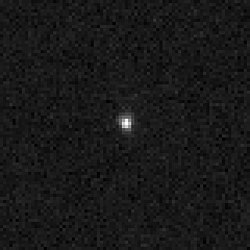Sedna (planetoid)

Sedna as imaged by the Hubble Space Telescope
|
|
| Discovery | |
|---|---|
| Discovered by |
Michael Brown Chad Trujillo David Rabinowitz |
| Discovery date | 14 November 2003 |
| Designations | |
| MPC designation | (90377) Sedna |
| Pronunciation | /ˈsɛdnə/ |
|
Named after
|
Sedna (Inuit goddess of sea and marine animals) |
| 2003 VB12 | |
|
TNO · detached sednoid |
|
| Orbital characteristics | |
| Epoch 13 January 2016 (JD 2457400.5) | |
| Uncertainty parameter 2 | |
| Observation arc | 9240 days (25.30 yr) |
| Earliest precovery date | September 25, 1990 |
| Aphelion | ≈ 936 AU (Q) 1.4×1011 km 0.015 ly |
| Perihelion |
76.0917±0.0087 AU (q) 1.1423×1010 km |
|
506.8 AU 7.573×1010 km |
|
| Eccentricity | 0.85491±0.00029 |
| ≈ 11400 yr | |
|
Average orbital speed
|
1.04 km/s |
| 358.163°±0.0054° | |
| 0° 0m 0.31s / day (n) | |
| Inclination | 11.92872° (i) |
| 144.546° (Ω) | |
| 311.29°±0.014° (ω) | |
| Physical characteristics | |
| Dimensions |
995±80 km (thermophysical model) 1060±100 km (std. thermal model) |
| 10.273 h (0.4280 d) | |
|
Sidereal rotation period
|
10.3 h ± 30% |
| 0.32±0.06 | |
| Temperature | ≈ 12 K (see note) |
| (red) B−V=1.24; V−R=0.78 | |
| 21.1 20.5 (perihelic) |
|
|
1.83±0.05 1.6 |
|
90377 Sedna is a large minor planet in the outer reaches of the Solar System that was, as of 2015[update], at a distance of about 86 astronomical units (AU) from the Sun, about three times as far as Neptune. Spectroscopy has revealed that Sedna's surface composition is similar to that of some other trans-Neptunian objects, being largely a mixture of water, methane, and nitrogen ices with tholins. Its surface is one of the reddest among Solar System objects. It is most likely a dwarf planet. Among the eight largest trans-Neptunian objects, Sedna is the only one not known to have a moon.
For most of its orbit, it is even farther from the Sun than at present, with its aphelion estimated at 937 AU (31 times Neptune's distance), making it one of the most distant-known objects in the Solar System other than long-period comets.
Sedna has an exceptionally long and elongated orbit, taking approximately 11,400 years to complete and a distant point of closest approach to the Sun at 76 AU. These facts have led to much speculation about its origin. The Minor Planet Center currently places Sedna in the scattered disc, a group of objects sent into highly elongated orbits by the gravitational influence of Neptune. This classification has been contested because Sedna never comes close enough to Neptune to have been scattered by it, leading some astronomers to informally refer to it as the first known member of the inner Oort cloud. Others speculate that it might have been tugged into its current orbit by a passing star, perhaps one within the Sun's birth cluster (an open cluster), or even that it was captured from another star system. Another hypothesis suggests that its orbit may be evidence for a large planet beyond the orbit of Neptune.
...
Wikipedia
